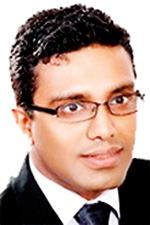Don’t lose faith, get back your face
Shattered to pieces!

X-ray showing shattered bones of a road traffic accident victim
It certainly was not his fortune, as is usually said, after he had foolishly shot himself in the face on Valentine’s Day, after an argument with his girlfriend.
Although his injuries were not life-threatening and had not made him blind, they were “devastating” and would have left him hideously disfigured, if not for the timely intervention of the Plastic Surgery Unit of the National Hospital.
A small scar of about one cm on his forehead, minus half of his tongue and loss of sensation on his lips were the only indications of the major trauma that his face had undergone, MediScene learns. Nearly 13 hours of surgery later through which most of his injuries were addressed and repaired, he emerged with a normal face, points out Consultant Plastic Surgeon Dr. Gayan Ekanayake whose special interest is craniofacial surgery, commending Consultant Neurosurgeon Dr. Saman Wadanambi for referring the patient to them without delay.
It is the importance of the face that Dr. Ekanayake stresses, explaining that “our faces give us our identities” and any major changes in the appearance would have serious social implications. All love their faces and would like to keep them as they are except for changing a few minor flaws here and there. However, sudden drastic changes can occur due to trauma to the face, leaving it mutilated and disfigured. “Just imagine waking up each morning and seeing such a face peering back at you from the mirror,” says Dr. Ekanayake.
The facial appearance is governed by the facial skeleton, which maintains its shape and gives it the distinct look that it has. If the small bones that make up the face fracture or break and are not put right soon, a deformity will be the result, he explains. Such deformities commonly come about due to fractures of:
- The nasal bone, leaving a crooked nose.
- The cheek bones, which would result in the loss of the contour of the face on the affected side.
- The bones surrounding the eyes.

Dr. Gayan Ekanayake
Most facial bones are soft and brittle, except the mandible which is the strongest bone in the face, according to Dr. Ekanayake, and break very easily. These facial bones also have cavities in them which determine the quality of a person’s voice and shape of the face.
Referring to how facial fractures can occur, Dr. Ekanayake says a majority are due to road traffic accidents although the exact number has not been collated. The other causes could be violence, such as punches or stinging slaps on the face, and incidental accidents such as falls from a height. Earlier people would come in with facial injuries, having been shot by someone else but such incidents have declined, with a few reporting self-inflicted gunshot wounds on the face.
Comparing the Sri Lankan situation to that in Australia, he points out that facial injuries in road accidents are fewer there than here because of the stringent safety measures. However, violence against people where the face is targeted is more common over there.
With the complexity of facial injuries ranging from “mild fractures to blown-out gross fractures of the entire face”, MediScene understands that even if a person loses his full face he will not die unless he has suffered another life-threatening injury.
The treatment would either be “watchful waiting”, as the Plastic Surgeons would not rush into surgery unless the facial bones get displaced or move around and there is a need to “fix” them.
The “fixing” under general anaesthesia, says Dr. Ekanayake, is done with titanium plates which are light and “easily bio-integratable”. These titanium plates are not rejected by the body, while they are also safe if the patient has to undergo Magnetic Resonance Imaging (MRI).
CT scans and X-rays will be scrutinized and the surgery planned to the minutest detail, as the main aim is to leave a minimum number of scars on the face, he says, adding that here the skills of the Plastic Surgeons would come into play, built up on the technique of soft-tissue handling and advanced training in suturing.
While the Plastic Surgeons must think three-dimensionally for the best result, the suturing (stitching) needs to be done “tenderly and cautiously” as even the slightest damage to the skin will change the appearance.
Once the plate is fixed, the onus of taking care of the face would fall to the patient as he would have to avoid hard food and be on a soft diet so as not to displace the plate. Regular check-ups are also a necessity, MediScene learns.
Facial fractures need to be fixed either immediately or within a week, he says, urging that the patient should not waste time as the more time passes it is extremely difficult to fix faces.
Getting down to the bare bones, this Plastic Surgeon points out that if a person has lost pieces of bone in such situations as explosions, the medical team may have to perform advanced reconstruction by taking “spare bones” from elsewhere such as the skull or leg, and use it along with soft tissue such as the skin.
“Facial surgery is also not always risk-free. Although it’s extremely rare, there could be the risk of infection which may compel the removal of the plate,” he says. Another vital ingredient for a successful plate-implant is for the patient to undergo scar-management rehabilitation with the Plastic Surgery team, it is learnt.
Dr. Ekanayake’s “classic example” of the patient who came with his face, including palate and jaw shattered, did go back into society with his bones back in place.
“It was a shell with a huge cavity beneath,” says Dr. Ekanayake giving a hint of the miraculous job done at the National Hospital’s Plastic Surgery Unit.
Plastic Surgeons including Craniofacial Surgeons can provide cutting edge technology to make people retain their faces as well as their dignity.


